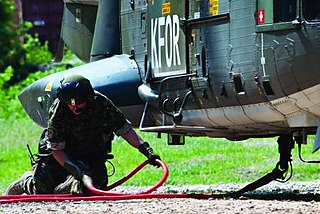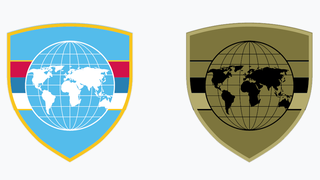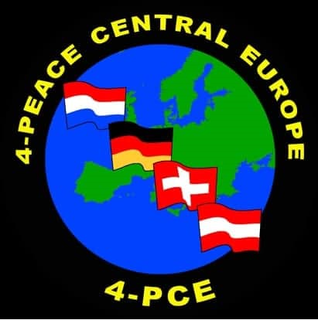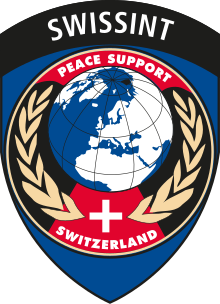
The Ghana Armed Forces (GAF) is the unified armed force of Ghana, consisting of the Army (GA), Navy (GN), and Ghana Air Force.

The Italian Armed Forces encompass the Italian Army, the Italian Navy and the Italian Air Force. A fourth branch of the armed forces, known as the Carabinieri, take on the role as the nation's military police and are also involved in missions and operations abroad as a combat force. Despite not being a branch of the armed forces, the Guardia di Finanza is part of the military and operates a large fleet of ships, aircraft and helicopters, enabling it to patrol Italy's waters and to eventually participate in warfare scenarios. These five forces have military status and are all organized along military lines, comprising a total of 341,250 men and women with the official status of active military personnel, of which 165,500 are in the Army, Navy and Air Force. The President of the Italian Republic heads the armed forces as the President of the High Council of Defence established by article 87 of the Constitution of Italy. According to article 78, the Parliament has the authority to declare a state of war and vest the necessary powers in the Government.

The Army of the Republic of North Macedonia is a defense force consisting of an army and air force; it is responsible for defending the sovereignty and territorial integrity of North Macedonia. Since 2005, it is a fully professional defense force compatible with NATO standards.
The Swedish Armed Forces is the government agency that forms the armed forces of Sweden, tasked with the defense of the country as well as with promoting Sweden's wider interests, supporting international peacekeeping, and providing humanitarian aid. It consists of the Swedish Army, the Swedish Air Force and the Swedish Navy, as well as a military reserve force, the Home Guard. Since 1994, all Swedish military branches are organized within a single unified government agency, headed by the Supreme Commander, even though the individual services maintain their distinct identities.

The Slovenian Armed Forces or Slovenian Army are the armed forces of Slovenia. Since 2003, it is organized as a fully professional standing army. The Commander-in-Chief of the SAF is the President of the Republic of Slovenia, while operational command is in the domain of the Chief of the General Staff of the Slovenian Armed Forces.
The Swiss Armed Forces operates on land and in the air, serving as the primary armed forces of Switzerland. Under the country's militia system, regular soldiers constitute a small part of the military and the rest are conscripts or volunteers aged 19 to 34. Because of Switzerland's long history of neutrality, the Swiss Armed Forces do not take part in conflicts in other countries, but do participate in international peacekeeping missions. Switzerland is part of the NATO Partnership for Peace programme.

The Portuguese Armed Forces are the military of Portugal. They include the General Staff of the Armed Forces, the other unified bodies and the three service branches: Portuguese Navy, Portuguese Army and Portuguese Air Force.

Civil-Military Co-operation (CIMIC) is the means by which a military commander connects with civilian agencies active in a theatre of operations.

The Norwegian Armed Forces is the military organisation responsible for the defence of Norway. It consists of four branches, the Norwegian Army, the Royal Norwegian Navy, which includes the Coast Guard, the Royal Norwegian Air Force, and the Home Guard, as well as several joint departments.
Civil Affairs (CA) is a term used by both the United Nations and by military institutions, but for different purposes in each case.

The United Nations Mission in Liberia (UNMIL) was a peacekeeping force established in September 2003 to monitor a ceasefire agreement in Liberia following the resignation of President Charles Taylor and the conclusion of the Second Liberian Civil War. The peacekeeping mission formally withdrew on 30 March 2018. At its peak it consisted of up to 15,000 United Nations military personnel and 1,115 police officers, along with a civilian component. It superseded the United Nations Observer Mission in Liberia (UNOMIL). As of July 2016, 1,240 U.N. military and 606 police personnel remained on the ground, but were there only in case of emergency.

The Kenya Army is the land arm of the Kenya Defence Forces.
The Peace Support Training Centre (PSTC), is located at McNaughton Barracks, CFB Kingston, Ontario, Canada, and is a subordinate unit of the Canadian Army Doctrine and Training Centre. PSTC delivers training to the Canadian Armed Forces (CAF), other Canadian Government Departments (OGDs), and foreign militaries. PSTC is also engaged in instructor exchanges with ABCA, NATO, and other countries.

The Swisscoy is an association of the Swiss Armed Forces in Kosovo. It is provided as part of the KFOR of NATO military mission to promote peace. The association contains a contingent of more than 165 people who are available and funded from Switzerland.

The Multinational Medical Coordination Centre/European Medical Command (MMCC/EMC) is a medical coordinating centre in support of the European medical services. It is directly subordinated to the German Armed Forces Joint Medical Service Command and the German Surgeon General. It was formed on 1 April 2018 in the Rhine-Barracks, Koblenz, Germany, where it also has its HQ.

Peacekeeping Operations Center (PKOC) is a unit of the Joint Operations Command within the General Staff of the Serbian Armed Forces. It is the major authority for training, selection, equipping, preparation and deployment of individuals and units from the Ministry of Defense and Serbian Armed Forces to multinational operations outside the borders of the Republic of Serbia.

Fo(u)r Peace Central Europe, occasionally, especially in informal correspondence, on logos, patches or similar 4 Peace Central Europe or 4-PCE or 4PCE refers to a military cooperation between military training centers in Germany, the Netherlands, Switzerland and Austria. The stylisation is supposed to unite two things in one term: both the statement that there are four nations and that they act for peace in Central Europe or shoulder to shoulder from Central Europe for world peace. The exercise and training centers are the:
This article represents the structure of the Swiss Armed Forces as of 1 January 2018:
Lt. Col. Richard Brennan is a Barrister-at-Law in the Legal Service of the Irish Defence Forces (IDF) and former National Legal Advisor to the IDF during United Nations peacekeeping operations as a United Nations Military Observer. He is a legal scholar on international humanitarian law and the legal basis of peacekeeping missions.

National Defence College (NDC), formerly known as National War College (NWC), is an apex military training institution of Nigeria for senior military officer of the Nigeria Armed Forces.
















